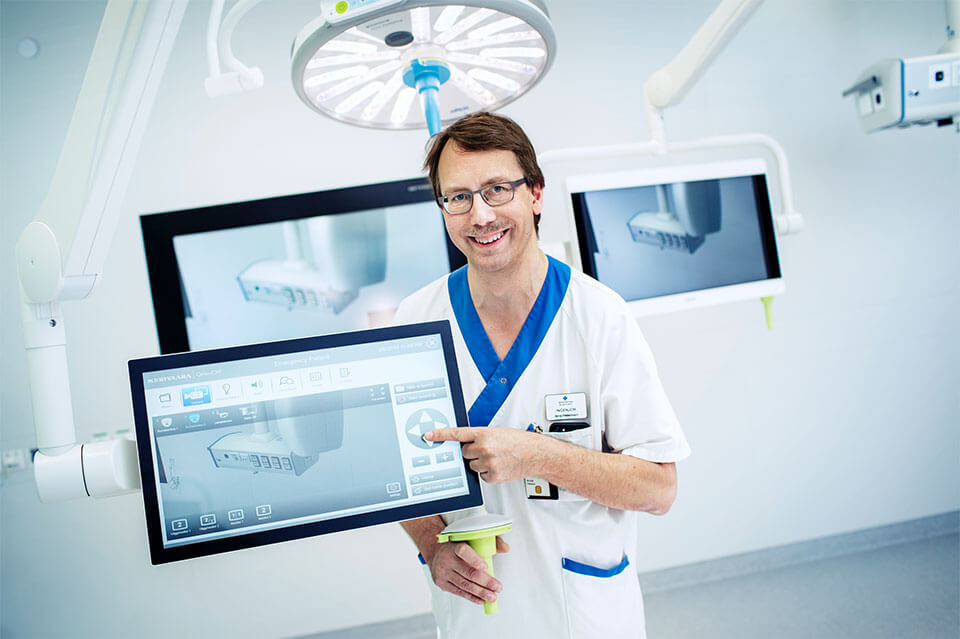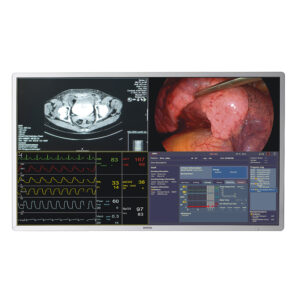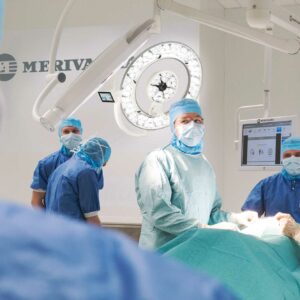Uppsala University Hospital has chosen to equip its new operating rooms with a totally new concept. An advanced integration system that, in principle, controls the majority of the room functions and medical devices.
New system simplifies the workflow
A large number of ultramodern operating rooms and treatment rooms are now ready to be taken into use in the new building, Hus 100/101. Thirteen of them have been equipped with the new concept, an automatic central system that will noticeably ease, simplify and streamline the workflow during operations and treatments.
– It integrates all of the important control functions, such as image and video processing, operating table and lighting control, as well as remote access, into a single system. Also recording for storage and training, explains Sebastian Brieger, Sales Manager for the manufacturer, Merivaara AB. He reckons that this type of integration system will eventually be standard at all large hospitals.
– It feels like a particularly great honour to be entrusted to install our integration system in the University Hospital, which is among the very best Swedish hospitals, Sebastian Brieger says.
New technology an important step for the hospital
Arne Pettersson, who is a hospital engineer and responsible for the technical function of the new integration system, sees the new technology as a major and important step in developing the work in the hospital’s operating rooms.
– This is the first complete integration system that controls everything in the room, including video conferences and connected telephones. This means great benefits, not least the option for preset scenarios, with everything at the push of a button, Arne Pettersson says.
The system, which was developed in collaboration with surgical nurses and physicians, is thus very user friendly, with large clear buttons on a touchscreen panel. Moreover, it is built on an open architecture, which makes it possible both to add new special functions and products from other suppliers. Even to introduce new functions, all of this based on the hospital’s future needs.
Many benefits from the OpenOR management system
Gustav Linder, who is a specialist in general surgery, was involved in the procurement and is looking forward to working with the new system live. He sees many benefits and gives a few examples.
– While we are operating, we can, for example, adjust the information we need, what is shown where and when on the various screens. For example, during an operation we may need to examine a tumor image that was taken earlier during gastroscopy of the patient’s stomach. We can have several camera images up simultaneously during the course of the operation, change how and where the images are projected and even move the screens as needed, Gustav Linder explains. He also sees it has an advantage that the system can be integrated with standard monitoring equipment for heart function, blood pressure and so on. This means that the surgeon can monitor the patient’s vital functions during the entire operation.
– A surgeon who, perhaps, encounters a problem at night can, moreover, consult with the on-call physician, who, via the system, can follow the operation live at a distance, via his or her computer. Moreover, also show exactly how the operation should be performed by marking and drawing on the image. The image system also means it is easy to link students and visitors to the operating room. In other words, they can also be present and learn during the actual operation without, as before, needing to enter the room.
Needs
To find a system that will ease, simplify, and streamline the workflow during operations and treatments.
Benefits
- A system that integrates all important control functions, such as image and video processing, operating table and lighting control, as well as remote access, into a single system. The OpenOR also records for storage and training purposes.
- The system is built on an open architecture, which makes it possible both to add new special functions and products from other suppliers, or to introduce new functions for future needs.
- It is very easy to control the OpenOR with an intuitive user interface in users’ own language.
While we are operating, we can, for example, adjust the information we need, what is shown where and when on the various screens.
Gustav Linder | Specialist in general surgery | Uppsala University Hospital



